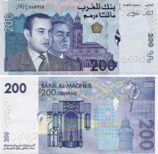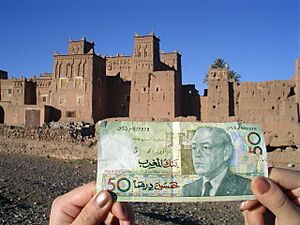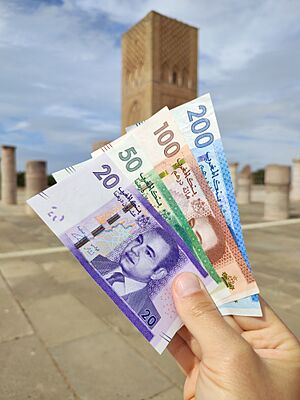Moroccan dirham facts for kids
Quick facts for kids Moroccan dirham |
|||
|---|---|---|---|
|
|||
| ISO 4217 Code | MAD | ||
| User(s) | |||
| Inflation | 0.2% | ||
| Source | The World Factbook, 2019 est. | ||
| Pegged with | 60% EUR and 40% USD | ||
| Subunit | |||
| 1⁄20 | rial (informal) | ||
| 1⁄100 | santim (official) franc (informal) |
||
| Symbol | DH | ||
| santim (official) franc (informal) |
santimat | ||
| Coins | 10, 20 santimat, ½, 1, 2, 5 & 10 dirhams | ||
| Rarely used | 1 santim, 5 santimat | ||
| Banknotes | 20, 50, 100, 200 dirhams | ||
The Moroccan dirham (Arabic: درهم, romanized: dirham) is the official money used in Morocco. It is often shown with the sign DH. The Bank Al-Maghrib, which is Morocco's central bank, is in charge of making and issuing the dirham. One Moroccan dirham is divided into 100 smaller units called santimat.
Contents
History of the Moroccan Dirham
The word dirham comes from an old Greek coin called the drachma. In Morocco, a silver coin called the Idrissid dirham was made between the 8th and 10th centuries. This happened during the time of the Idrisid dynasty.
Before 1882, Morocco used different types of coins. They had copper coins called falus, silver coins called dirham, and gold coins called benduqi. In 1882, the dirham became part of a new money system. At that time, 10 dirhams were equal to 1 Moroccan rial.
In 1912, most of Morocco became a French protectorate. This meant France had control over the country. Morocco then started using the Moroccan franc as its money. The dirham was brought back on October 16, 1960. It became the main currency again. However, the franc was still used until 1974, with 1 dirham being worth 100 francs. In 1974, the santim replaced the franc as the smaller unit.
On November 24, 2023, the Bank Al-Maghrib showed off new banknotes and coins. This included a new 100 dirham banknote.
Moroccan Dirham Coins
In 1960, the first silver 1 dirham coins were made. Later, in 1965, nickel 1 dirham and silver 5 dirham coins were introduced. When the santim was brought in during 1974, new coins were made. These included 1, 5, 10, 20, and 50 santimat, along with 1 and 5 dirham coins.
The 1 santim coins were made of aluminum. The 5 to 20 santimat coins were made of brass. The 50 santimat, 1 dirham, and 5 dirham coins were made of cupro-nickel. In 1980, new cupro-nickel 5 dirham coins were added. These changed to bi-metal coins in 1987. Bi-metal coins are made of two different metals joined together.
The 1 santim coin was only made until 1987. After that, new coin designs came out. A 1⁄2 dirham coin replaced the 50 santimat coin. It had the same size and materials. The new 5 dirham coin was bi-metallic. A 10 dirham bi-metallic coin was also introduced in 1995. Cupro-nickel 2 dirham coins were added in 2002.
In 2012, a brand new series of coins was released. The 5 and 10 dirham coins in this series have a special security feature. This feature changes its look when you tilt the coin. In 2023, another new series of coins was released for use in Morocco.
| 2012 Dirham Coins | |||||||
|---|---|---|---|---|---|---|---|
| Value | Technical parameters | Description | |||||
| Diameter | Mass | Composition | Edge | Obverse | Reverse | ||
| 10 santimat | 20 mm | 3 g | Nordic gold 89% copper 5% aluminium 5% zinc 1% tin |
Reeded | Arms of the Kingdom and inscription "Kingdom of Morocco" | Saffron flower and bee | |
| 20 santimat | 23 mm | 4 g | Reeded | Lotus flower and design representing Earth | |||
| 1⁄2 dirham | 21 mm | 4 g | Cupronickel 75% copper 25% nickel |
Reeded | Arms of the Kingdom and inscription "Kingdom of Morocco" | Design representing fish in the ocean | |
| 1 dirham | 24 mm | 6 g | Reeded | Mohammed VI | Arms of the Kingdom and inscription "Kingdom of Morocco" | ||
| 5 dirhams | 25 mm | 7.5 g | Ring: Cupronickel (as 1 dirham) Center: 70% Cu 24.5% Zn 5.5% Ni |
Segmented reeding | Mohammed VI | Hassan II mosque, with security feature | |
| 10 dirhams | 28 mm | 12 g | Ring: Aluminium bronze (as 5 santimat) Center: Cupronickel (as 1 dirham) |
Reeded with Stars Inscription | Mohammed VI (earlier issues show Hassan II) | Boumalne Dades, with security feature | |
| For table standards, see the coin specification table. | |||||||
Moroccan Dirham Banknotes
The first banknotes that used the dirham name were actually older franc notes with new stamps on them. These were 50 dirhams (on 5,000 francs) and 100 dirhams (on 10,000 francs). In 1965, new banknotes for 5, 10, and 50 dirhams were printed.
100 dirham notes were introduced in 1970. Then, 200 dirham notes came out in 1991, and 20 dirham notes in 1996. The 5 dirham notes were replaced by coins in 1980. The 10 dirham notes were also replaced by coins in 1995.
In October 2009, the Bank Al-Maghrib printed four million special 50-dirham banknotes. This was to celebrate the bank's 50th birthday. This special note shows the pictures of Kings Mohammed VI, Hassan II, and Mohammed V. The back of the note features the Bank Al-Maghrib building in Rabat.
In December 2012, another special banknote was made. It was a 25-dirham note to celebrate 25 years of making banknotes at Dar As-Sikkah, Morocco's state printing works. This note was the first in the world to be printed on Durasafe. Durasafe is a special material made of paper, a polymer (plastic), and then more paper. This makes the note very strong and hard to copy.
On August 15, 2013, the Bank Al-Maghrib announced a new series of banknotes. These notes feature a picture of King Mohammed VI and the royal crown. Each note also shows a Moroccan door design. This design highlights Morocco's rich building history and shows how open the country is.
In 2019, the Bank Al-Maghrib released a 20-dirham banknote made from a polymer material. This was to celebrate King Mohammed VI being on the throne for 20 years. Polymer notes are more durable than paper ones.
| Banknotes of the Moroccan dirham |
|||||||||
|---|---|---|---|---|---|---|---|---|---|
| 1987 Series (Including 1991 Revision) | |||||||||
| Value | Dimensions | Obverse | Reverse | Main Colour | Description | Date of | |||
| Obverse | Reverse | Watermark | printing | issue | |||||
| 10 dirhams | 143 × 70 mm | Yellow and pink (1987) violet (1991) |
Hassan II | Moroccan lute, pillar | Hassan II | 1987 | 1987/ca. 1991 | ||
| 50 dirhams | 148 × 70 mm | Green | Hassan II | A fantasia scene | Hassan II | 1987 | 1987/ca. 1991 | ||
| 100 dirhams | 153 × 75 mm | Brown | Hassan II | The Green March into the Spanish Sahara (October, 1975), Desert rose | Hassan II | 1987 | 1987/ca. 1991 | ||
| 200 dirhams | 158 × 75 mm |  |
 |
Blue | Hassan II | Conch shell, a branch of coral, and a Dhow. | Hassan II | 1987 | ca. 1991 |
| 1996 Series | |||||||||
| 20 dirhams | 130 × 68 mm |  |
 |
Brown-reddish | Hassan II, Great mosque of Casablanca | Wall fountain of the Hassan II Mosque | Hassan II | 1996 | 1996 |
| 2002 Series | |||||||||
| 20 dirhams | 140 × 70 mm |  |
 |
Violet | Mohammed VI, "Bab Challah" (Challah gate) in Rabat | A panoramical view of the Oudayas | Mohammed VI and "20" | 2005 | 2005 |
| 50 dirhams | 147 × 70 mm |  |
 |
Green | Mohammed VI | A clay-made building (Ksour) | Mohammed VI and "50" | 2002 | 2002 |
| 100 dirhams | 150 × 78 mm |  |
 |
Brown | Mohammed VI, Mohammed V and Hassan II | The Green March into the Spanish Sahara (October, 1975) | Mohammed VI and "100" | 2002 | 2002 |
| 200 dirhams | 158 × 78 mm |  |
Blue | Mohammed VI and Hassan II, Grand mosque of Casablanca | A window of the Hassan II Mosque, Lighthouse of Casablanca (Pointe el-Hank) | Mohammed VI and "200" | 2002 | 2002 | |
| 2013 Series | |||||||||
| 20 dirhams | 131 × 70 mm |  |
 |
Purple, orange and blue | Mohammed VI, coat of arms of Morocco | Train crossing Hassan II Bridge over the Bou Regreg river in Rabat; Hassan II Mosque and city buildings in Casablanca | Mohammed VI and electrotype 20 | 2012 | 2013 |
| 50 dirhams | 138 × 70 mm |  |
 |
Green, yellow and blue | Mohammed VI, coat of arms of Morocco | Ouzoud Falls; argan tree, fruit, and bird | Mohammed VI and electrotype 50 | 2012 | 2013 |
| 100 dirhams | 145 × 70 mm |  |
 |
Brown, yellow, violet and blue | Mohammed VI; coat of arms of Morocco | Mohammed VI and electrotype 100 | 2012 | 2012 | |
| 200 dirhams | 151 × 70 mm |  |
 |
Blue, green and violet | Mohammed VI; coat of arms of Morocco | Cargo ship, gantry cranes, and shipping containers in the port of Tangier; lighthouse and trees on Cape Spartel in Tangier | Mohammed VI and electrotype 200 | 2012 | 2012 |
| For table standards, see the banknote specification table. | |||||||||
How People Talk About Money in Morocco
In Morocco, people often use informal words to talk about money. These words are not official, but everyone understands them. For example, the rial is a common term. It is equal to 5 santimat. Another informal term is the franc, which is equal to 1 santim.
When people buy things that cost less than a dirham, they usually talk about the price in rial or santim. For very expensive items, like cars, people might even say the price in santimat. When speaking Arabic, people use rial. When speaking French, they use centime.
Older people who lived during the French colonial period might still use terms like 1,000, 2,000, or even 100,000 francs. These terms refer to 10, 20, and 1,000 dirhams today. The rial is also used for higher values, up to 5,000 dirhams (which is 100,000 rial). This way of speaking is common in Moroccan Arabic.
The Moroccan dirham is also accepted in markets in Ceuta. However, the euro is the official money there.
| Current MAD exchange rates | |
|---|---|
| From Google Finance: | AUD CAD CHF EUR GBP HKD JPY USD |
| From Yahoo! Finance: | AUD CAD CHF EUR GBP HKD JPY USD |
| From XE.com: | AUD CAD CHF EUR GBP HKD JPY USD |
| From OANDA: | AUD CAD CHF EUR GBP HKD JPY USD |
| From fxtop.com: | AUD CAD CHF EUR GBP HKD JPY USD |
See also
- Economy of Morocco
- United Arab Emirates dirham




